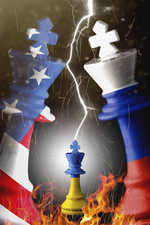| Home | About | Archives | RSS Feed |

@theMarket: Blood in the Streets
 |
It turns out that the president was correct in his warnings. Russia did invade Ukraine. Financial markets predictably crashed, but then rebounded. That's old news. What happens next?
In my last column, I wrote that the fate of the markets was in the hands of two big "ifs." One was an invasion of Ukraine by Russia. That has now occurred. That event broke the range the market was struggling to maintain on Thursday, Feb. 24. But by the end of the day Thursday the markets bounced back up big time. It was a classic investor behavior pattern of "sell the rumor, buy the news." Stocks fought to continue that bounce on Friday.
There is an old saying, attributed to Baron Rothschild, an 18th-century British nobleman, that "the time to buy is when there is blood in the streets." That famed member of the Rothschild banking family made a fortune buying into the panic that followed the Battle of Waterloo against Napoleon. But buying becomes a bit more difficult if the blood spilled happens to be yours.
I have tried to steer investors to safety over the last two months. Whether you listened or not, my target level has been 4,060 on the S&P 500 Index. This week we hit a low of 4,114. I guess you can say that was close enough for government work. As such, I would begin to add back equities into my portfolio, if you haven't already. But that does not mean that this pullback is over.
I do not expect a V-shaped recovery in these markets. We have yet to see a "capitulation" day where 90 percent of all stocks are sold. Rarely, if ever, is a market decline over without at least one capitulation day. In addition, geopolitical events like this Ukraine debacle usually lasts several months, not several days. If the fear index, called the VIX, remains above 20 (and it is right now above 29), we could still see 100-point swings or more in the index averages daily.
And as usual, Wall Street strategists, who were so bullish a month ago, are now predicting confidently that we could see the S&P 500 fall to 3,750. It is therefore not the atmosphere where stocks can soar into a new bull market. There is still a boat load of headline risk, so purchases should be done slowly and not all at once. Average in as the professionals usually do. And any adds you may decide to make should be in the more defensive sectors of the market at first.
Of course, the markets can go lower, or bottom a little higher than my predictions. In markets like these where geopolitical uncertainty can move markets wildly, don't expect precise measurements. Suffice it to say that most of the decline is over in my books.
The face-ripping rally we experienced this week is normal in bear markets. From the lows to the highs, the S&P 500 Index swung 180 points in a single day. We could easily see the reverse happen next week.
In this type of a downtrend, I believe we will need to test the lows and possibly go lower one, two, or even three times before this correction is over. That should take us close to the mid-March FOMC meeting. Even then, I am not expecting the overall market to come out of the doldrums before mid-year. Why?
My second big "if" of last week was the Fed. I am sure that the bond market will be wondering if their present expectations for seven interest rate hikes by the Fed this year remains a possibility. Could the Fed change its monetary tightening policy because of the invasion of Ukraine and resulting U.S. sanctions? My short answer is no.
Soaring oil and gas prices, and dislocations in the supply chain due to this geopolitical conflict, will only add upward pressure on the inflation rate. The Fed will continue to tighten, because they must, if we don't want to see hyperinflation. But I am not in the camp that seven rate hikes are being contemplated by the Fed membership. That premise is simply noise from a crowd of neophytes who have never worked in a rising interest rate environment. If the Fed raises interest rates even three times this year, I would be surprised.
That said, the Fed's monetary policy change will continue to pressure stocks through the first half of the year. That should cap any real upside we see going forward over the next three to four months. Still, flatlining by the stock market is better than going down I guess.
Bill Schmick is the founding partner of Onota Partners, Inc., in the Berkshires. His forecasts and opinions are purely his own and do not necessarily represent the views of Onota Partners Inc. (OPI). None of his commentary is or should be considered investment advice. Direct your inquiries to Bill at 1-413-347-2401 or email him at bill@schmicksretiredinvestor.com.
@theMarket: Stocks Trapped in a Box
 |
Over the next three weeks, equities will likely trade in a wide range. The caveat to that forecast: if the Fed suddenly changes policy, or if a shooting war erupts in Ukraine. Those are two big ifs. Unfortunately, I can neither forecast when or what the next Fed head will say, nor predict Vladimir Putin's next move.
The next Federal Open Market Committee meeting occurs in mid-March. The latest CPI and PPI inflation data shows inflation accelerating at a rate much higher than economists and the Fed expected. It is all but certain, according to the bond market vigilantes, that the Federal Reserve Bank will raise interest rates at that time. As such, it is only a question of whether the rate increase will be a 25 or 50 basis point hike.
That will be only part of the equation. Investors will be expecting Chairman Jerome Powell to give them more insight as to how many rate hikes they can expect going forward, and what other monetary tightening the Fed will be planning as well. The risk will be that the equity market could swoon and test the lows if the Fed is perceived as more hawkish on tightening than expected.
That in the meantime, we have plenty to occupy our attention. This week the market's interest rate worries have been superseded by Russia's intentions toward Ukraine. Thus far, the conflict has been played out in the media in a "he said, she said" war of charges and counter charges.
War is never a good thing, suffice it to say. But besides the human costs of such a conflict, there would also be an economic price to pay. The sanctions that the U.S. and its allies are prepared to inflict on Russia in response to perceived aggression would inflict damage on the global economy and on the U.S. as well.
Russia supplies a great deal of the commodities that the rest of the world consumes. Sanctions could immediately cause substantial price spikes in commodities such as oil, gas, and coal. Russia is also a major exporter of rare earth minerals and heavy metals. One third of the world's supply of palladium (used in catalytic converters), for example, and titanium (think aircraft) is also mined and exported by Russia.
Ukraine is also a major source of neon, an essential input in the manufacturing of semiconductors. The Ukraine is one of the world's largest producers of wheat, as well as fertilizers (as is Russia). Hostilities could damage their ability to export or even harvest the nation's wheat supply.
I would expect price spikes in several food commodities as a result. That would add fuel to the inflation fire and could force the Fed to become even more aggressive in raising interest rates. It would not be a pretty picture for stock market investors.
To be honest, no one knows whether Russia is bluffing or serious about invasion as a next step. For me, a telltale sign of their intent would be any movement of medical facilities and supplies forward to the troop staging areas and border with Ukraine. This week, I have seen just that.
The risk is obvious. A shooting war would probably see the S&P 500 Index re-test the lows (4,222) of Jan. 24. Geopolitical events usually have a limited impact on the stock market, unless the hostilities are protracted and far-reaching. If, on the other hand, a negotiated settlement was to occur, markets would likely fly higher. That "if" word is going to keep investors jumpy and prices in a box with every headline capable of moving markets 1-2 percent up or down.
Bill Schmick is the founding partner of Onota Partners, Inc., in the Berkshires. His forecasts and opinions are purely his own and do not necessarily represent the views of Onota Partners Inc. (OPI). None of his commentary is or should be considered investment advice. Direct your inquiries to Bill at 1-413-347-2401 or email him at bill@schmicksretiredinvestor.com.
@theMarket: Did the Bulls See Their Shadow?
 |
On Groundhog Day, Wednesday, Feb. 2, Punxsutawney Phil saw his shadow, predicting that there will be at least six weeks of winter weather ahead of us. Given the market action of the last few days, can we expect inclement weather ahead for market bulls as well?
Last week, I warned readers to expect the stock market to bounce. It did, retracing 50 percent of the market's decline in just about four days. I also warned that investors should not get comfortable with this bounce because after the bounce markets should go south once again. That prediction seems to be playing out.
It would be an understatement to say that markets remain volatile in both the stock and bond markets. Commodities, the currency and crypto markets are also gyrating like a championship bronco.
Part of the problem lies with the FANG stocks. These large-cap mega companies account for so much of the major averages and indexes, that when one or another of these stocks catch a cold, the markets catch pneumonia. Most recently Meta (formerly known as Facebook) missed earnings and gave poor guidance on Wednesday night. The stock dropped more than 22 percent overnight. It was the single largest loss of dollar value for a public company in U.S. history. All the major averages declined with it, with the NASDAQ falling 2.25 percent, while the S&P 599 Index fell almost 1.5 percent.
Just the day before, Alphabet (Google) did the opposite, gaining 20 percent on stellar earnings and took the indexes for a major rise upwards. On Thursday, Amazon surprised investors with what looked like a massive beat on earnings and gained 11 percent in overnight trading. At first the U.S. indexes traded more than a percentage point higher but gave that all back by the opening on Friday morning, and so did the markets.
Overall, corporate earnings have held up with roughly 75 percent beating numbers, but down from 82 percent last quarter. The size of the beats, compared to the last few quarters, have been anemic, while the number of revisions upward in future earnings have been few and far between. Obviously, none of this has been enough to hold up the stock market, let alone propel it higher. I warned investors that would turn out to be the case more than a month ago.
The omicron variant is evidently not taking its toll on the job market yet, according to the latest payroll numbers. Friday's employment numbers saw 467,000 job gains versus the forecasts of only 110,000 gains.
Investors, rather than celebrate the job gains, saw them as proof that inflation is still climbing. Wages, a key element of the inflation equation, continued to move higher. The Ten-year U.S. Treasury bond spiked higher on the news to more than 1.90 percent. My target, as I have advised investors in the past, is a 2 percent yield on the "Tens" in the short-term.
But let's get to the meat of this column — the markets, where now, given that my forecast that the markets would see a 10-20 percent correction between mid-January and February. That prediction has been accomplished at this point. I also signaled that we would bounce this week and we have. At its height the bounce retraced 61 percent of the losses on the S&P 500 Index. But I also warned that we should not get too comfortable with this bounce. The last two days brought this point home to those who doubted that warning. Now what?
The stock market took less than half the time to recoup 61 percent of its losses. Since then, the volatility has exploded both up and down. This volatility will continue. Next week, for example, we could see a similar pattern as last week — up for a few days, and then down.
In situations like this, over the longer term, we can expect to see a large "W" pattern in the market's behavior. We are about halfway through this pattern. At a bare minimum, we should see the markets (S&P 500 Index) retest its recent lows of 4,222 (on January 24, 2022). But it doesn't have to stop there. As I wrote two weeks ago, we could see a decline to 4,070 if investors begin to panic. But we could also see a higher low as well. Right now, the markets are in a state of indecision.
Given this potential scenario, I don't believe it is time to be a hero. If we retest the recent lows, sure, put a little money to work, but don't bet the house. From there, if it goes lower, start averaging in. The same maneuver could be applied on the upside as well, if 4,222 is truly the bottom. How will you know? Keep reading my columns.
Bill Schmick is the founding partner of Onota Partners, Inc., in the Berkshires. His forecasts and opinions are purely his own and do not necessarily represent the views of Onota Partners Inc. (OPI). None of his commentary is or should be considered investment advice. Direct your inquiries to Bill at 1-413-347-2401 or email him at bill@schmicksretiredinvestor.com.
@theMarket: Corporate Guidance Sends Stocks Lower
 |
Across several industries, corporate executives are guiding investor's expectations lower during this fourth-quarter 2021 earnings season. To me, it is just added another nail in the coffin of bullish sentiment.
Pick your poison. The money center banks earnings beat on the bottom line, but it was the commentary and nuanced forward guidance that dismayed investors. Airlines did OK, but also warned of tough times ahead due to higher fuel costs, and the Omicron variant. Companies in other sectors (such as Netflix) warned of thinner profit margins ahead due to higher costs, less demand and/or supply chain issues.
None of this should come as a surprise to my readers. I expected a mounting chorus of woeful predictions (real and imagined) by executives, who are eager to cover their butts in the event things don't go their way over the next quarter or two. Lower guidance is one, but not the only reason, I am expecting further downside in the markets ahead.
The U.S. 10-year Treasury bond yield is another reason. This week, the bond yield hit 1.86 percent, which was a 40 percent increase since the beginning of December 2021. I expect the yield to hit 2 percent, which is another 7 percent gain from here. Is it any wonder, given that fixed income analysts are outdoing themselves (like lemmings) in predicting more rate hikes this year and sooner? "Four or more," says one analyst from a big brokerage house. "I'll see you four and raise you eight," says another.
Bottom line — a 7 percent inflation rate is a real problem. Even President Biden, in his televised two-hour press conference this week, had to remind all of us that "it is the Fed's job to fight inflation." Anyone (and there are many) who may have been hoping that a stock market decline would cause President Biden to pressure the Fed into backing off from raising interest rates has been put on notice — there is no longer a Fed put under the stock market. It would take a 20 percent decline or more, I believe, before the Fed might have change of heart, if then.
Another of my forecasts slower growth is starting to unfold. The economy is beginning to feel the back up in interest rates. Take the housing sector, for example. A 30-year conventional fixed rate mortgage traded at 3 percent a few short weeks ago. Today, that rate is 3.7 percent on average.
Since mortgage rates are super sensitive to even a small rise in interest, I would expect existing home sales to begin to falter. And as mortgage rates climb higher, less people may be willing to stand in line and pay up for that house. The housing sector is a huge segment of U.S. GDP. But it won't collapse. I'm not expecting the housing market to do more than slow a tad, but that is enough to scare investors. The good news, I suppose, is that over time prices will come down. That should help reduce the overall inflation pressure. But the key word here is time.
Unfortunately, markets aren't about to wait for this kind of scenario to unfold. About the longest investors can wait in today's markets is until the next Fed meeting, which just happens to be next week. On Wednesday, Jan. 26, 2022, traders are expecting an announcement from the Fed spokesmen that there could be as many as four interest rate hikes (of 25 basis points each) in 2022.
That won't exactly be good news, but at least it is expected, or at least I hope so. Anything more, and I would say "look out below." A hawkish comment or two from Federal Reserve Bank Chairman, Jerome Powell, could easily swing the market up or down 75 to 100 points on the S&P 500 Index.
We have already passed the start date (Jan. 15, 2022) of the correction I predicted several weeks ago. I have been warning readers of a 10-20 percent decline between that date and the end of February. So far, the NASDAQ has fallen more than 10 percent, the consumer discretionary sector is down 8 percent, healthcare down 6.5 percent, real estate down 8.6 percent, and materials down 5 percent. The S&P 500 Index is only down 7 percent while the Dow has done the best only falling 5 percent.
I was hoping that readers took advantage of the few rally attempts we had this past week to reduce positions further and get more conservative. I advise you to do the same in the coming week, if we get another bounce or two. It is not the time to "buy the dips", but rather my advice is to sell the rips. Once the S&P 500 Index has hit my 10 percent target, we will reassess for further downside.
Bill Schmick is the founding partner of Onota Partners, Inc., in the Berkshires. His forecasts and opinions are purely his own and do not necessarily represent the views of Onota Partners Inc. (OPI). None of his commentary is or should be considered investment advice. Direct your inquiries to Bill at 1-413-347-2401 or email him at bill@schmicksretiredinvestor.com.
@theMarket: Beware the Hikes of March
 |
There is a more than an even chance that the Federal Reserve Bank hikes interest rates at least 25 basis points by the end of March 2022. Several analysts expect another three hikes by the end of the year. As an equity investor, this should concern you.
This week, both the Consumer Price Index (CPI), and the Producer Price Index (PPI) came in as expected. But "expected" does not mean anything like good on the inflation front. On a year-over-year basis CPI was up 7 percent, while PPI hit 9.7 percent for all of 2021.
And while economists debate whether inflation and economic growth will subside over the course of this year, the Omicron variant is throwing a big kink into those forecasts.
In my Jan. 13, 2022, column "No Shows Threaten Economy," I pointed out the millions of workers in the global labor force who have been forced to stay off the job while recovering from this highly contagious variant. It has also created additional delays in the supply chain. Container and cargo congestion is building among the world's 20 largest ports.
Since much of the inflation rise has been caused by supply chain problems, the short-term impact of more delays indicates to me, a higher rate of inflation going forward. As such, the Fed seems honor-bound to raise rates faster (and maybe at 50 basis points, instead of the expected 25) in order to deliver on their promise to contain inflation.
But the bond vigilantes over in the fixed income markets have already taken matters into their own hands. They have bid up the U.S. Ten-Year Bond yield to 1.72 percent. At one point this week, it climbed to above 1.8 percent. Most bond traders are now expecting yields to rise to 2 percent through the next few months.
As such, foreign investors, who usually line up to buy U.S. Treasury bonds in the government's frequent auctions, have not been as eager to do so. This week's 10- and 30-year auctions were meh, at best. None of this has been good for the stock market.
If you have been reading my columns, you know that technology companies do not do well in an environment of rising interest rates. The high-flyers, that is stocks with little or no earnings but huge price gains, have been bearing the brunt of the downward pressure. But even the big guys are feeling the pressure at this point, with the NASDAQ 100 down 10 percent from its highs.
Every time these market favorites try to get up off the floor, they are pounded down again. Investors, trained to "buy the dip," are getting their fingers chopped off. In fact, underneath most indexes, everything that qualifies as speculative, whether it's crypto, electric vehicles, marijuana stocks, Fintech, etc. have been all been taken to the woodshed.
Those readers who have followed my advice have hopefully avoided much of the carnage. If you haven't acted to reduce the leverage in your portfolios, there is still time. I am expecting that we will see an oversold bounce in the stock market on Tuesday next week for a few days. Why?
Earnings season is now upon us. Most investors eagerly anticipate the "FANG" companies' results and usually buy stocks in anticipation of that event. Since they are such a large weighting in the overall market, great FANG earnings usually buoy the entire market. As such, I would expect the same thing will happen again.
The fly in that ointment is that while earnings may be stellar, guidance won't be. Between the omicron variant, supply chain issues, inflation, and the Fed's tightening stance on interest rates, the near-term future that FANG executives see, I'm guessing may not be as rosy as many investors expect.
If I am right, and the markets do bounce, take that opportunity to reduce exposure to the overall market. I am still looking for a serious correction in the weeks ahead. If the correction is steep enough, chances are that the Fed might back off on further tightening, but at this point that is just a supposition based on past Fed behavior. In any case, we'll cross that bridge when we come to it.
Bill Schmick is the founding partner of Onota Partners, Inc., in the Berkshires. His forecasts and opinions are purely his own and do not necessarily represent the views of Onota Partners Inc. (OPI). None of his commentary is or should be considered investment advice. Direct your inquiries to Bill at 1-413-347-2401 or email him at bill@schmicksretiredinvestor.com.

